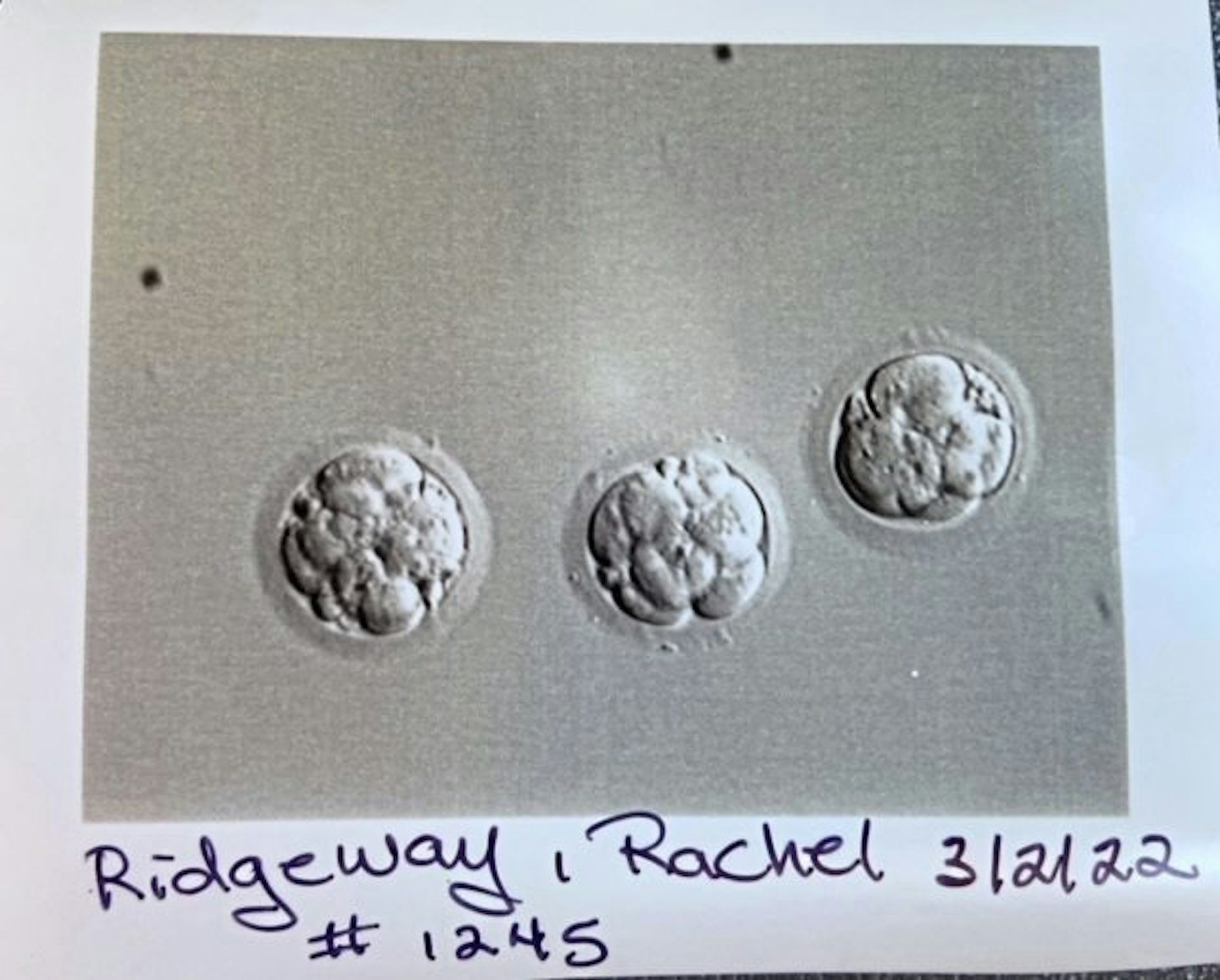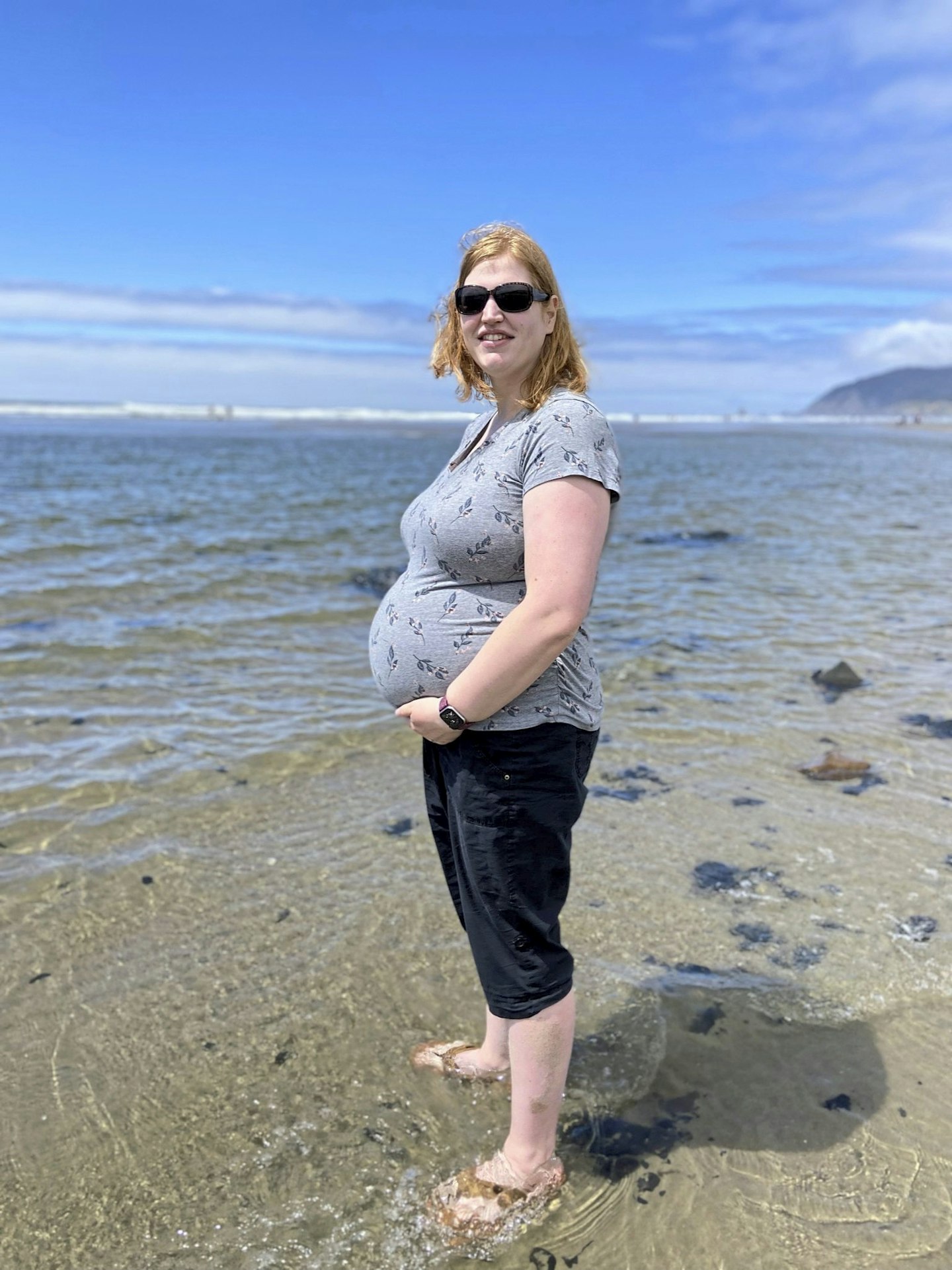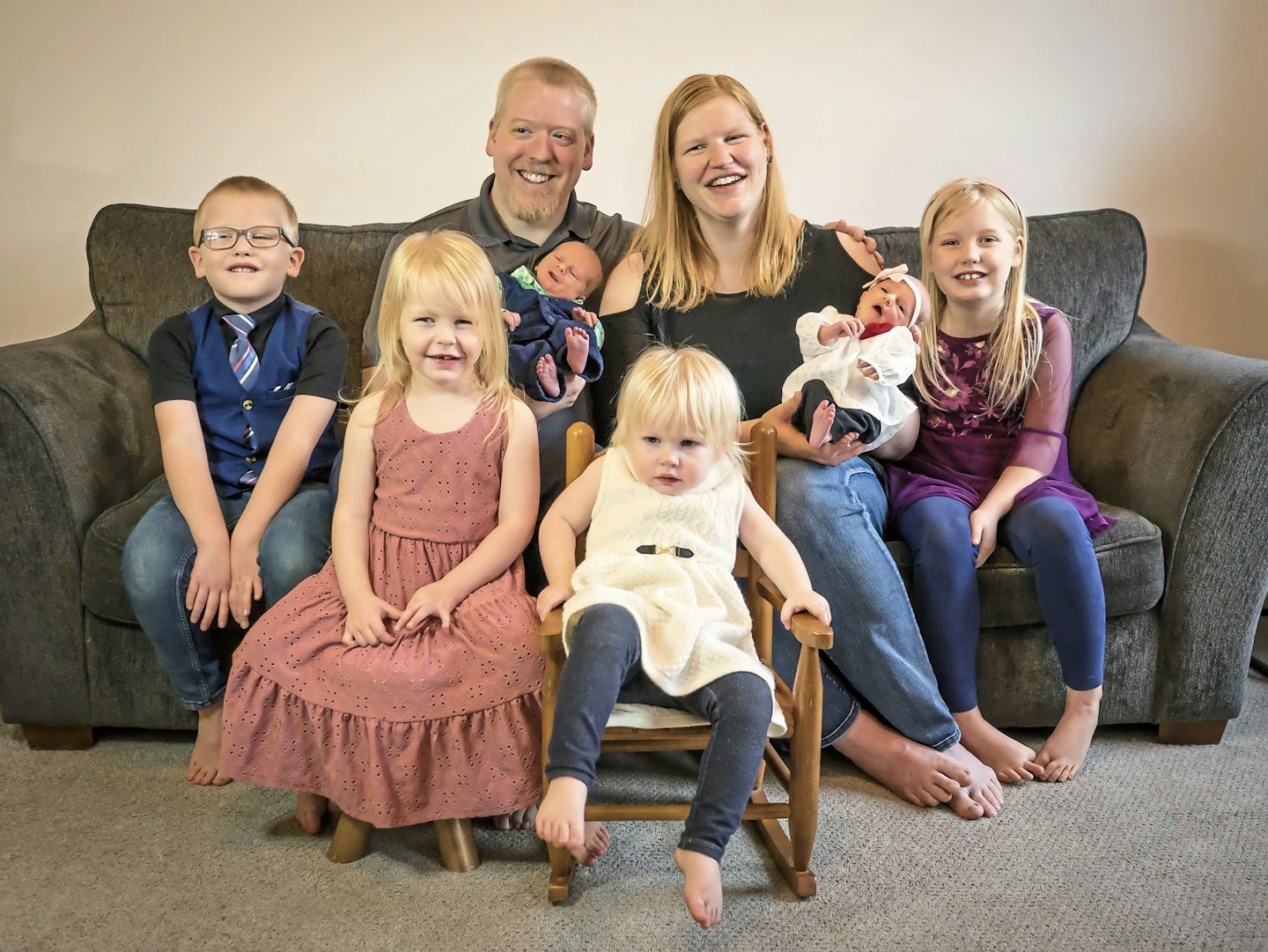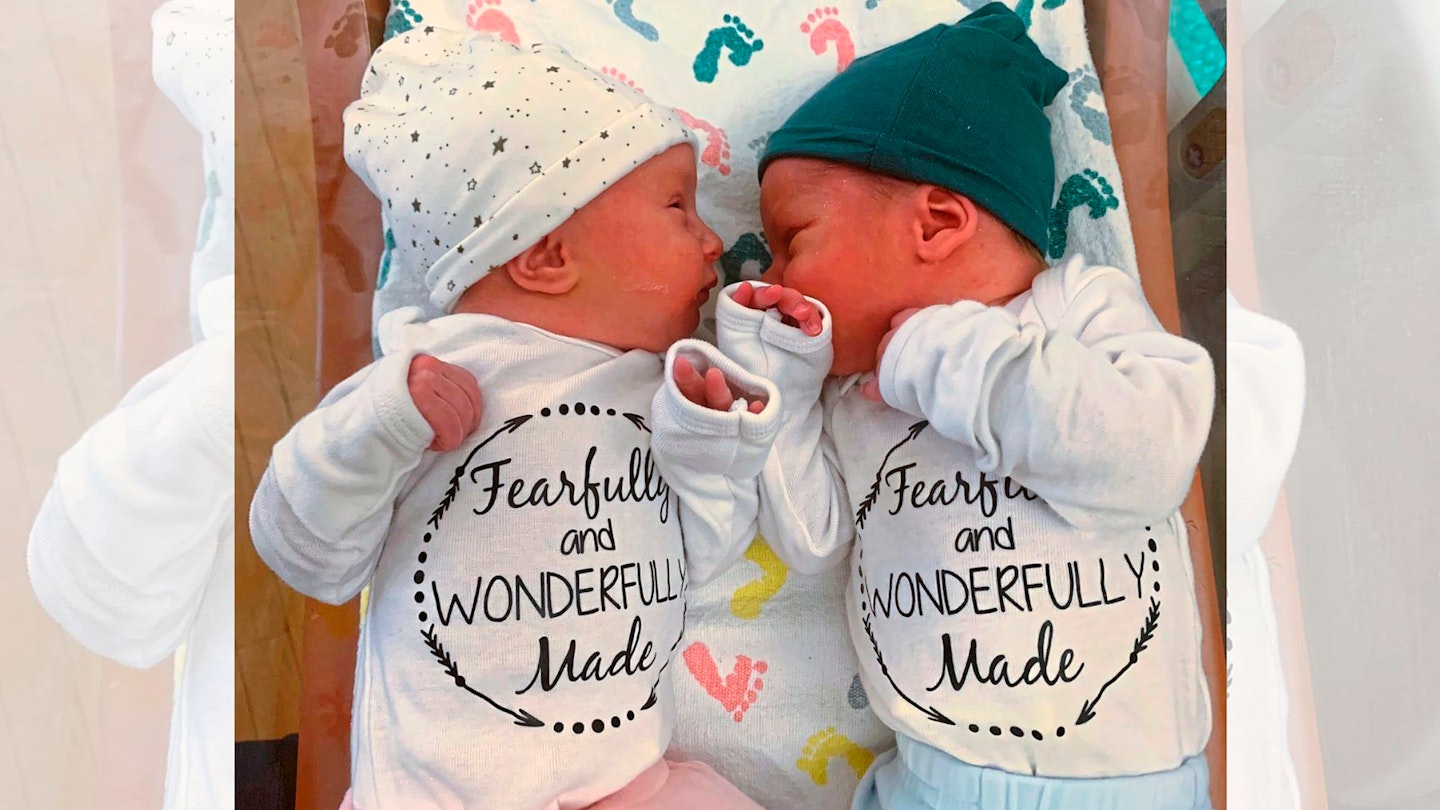Rachel and her hubby are raising two tiny time travellers…

I blinked and looked again at the pregnancy test in my hand.
‘It definitely still says positive,’ I said to my husband Phil.
I couldn’t quite take it in.
We had met and married within a year and we’d both hoped a baby would follow soon after.
Month after month, however, we’d been disappointed.
Tests had shown everything was fine with Phil, but I’d been scared to get tested myself.
What if the reason we weren’t conceiving was complex or serious?
Finally, four years on, I’d visited a specialist, who’d found I wasn’t ovulating regularly.
I’d been given medication to stimulate my ovaries and now — just a month later — it seemed it had worked.
Our daughter Naomi was followed a couple of years later by a son, Joshua. Another daughter, Eliora, arrived three years after that.
It was when Phil and I started thinking about a fourth child that an idea we’d had a long time before came up again.
I don’t remember exactly when or how I’d first heard that you could ‘adopt’ embryos which had been left over from fertility treatment.
But the idea had stuck in my head.
As a Christian, I strongly felt that from the moment of conception, a life had begun.
'Let's give these guys their shot'
Learning there were over a million embryos in storage in America alone felt like a tragedy to me.
So many lives left on hold — all those potential children, waiting for a mother and father to give them a chance.
Going through infertility had made us even more aware how precious each life was.
The more I thought about it, the more eager I was to give birth to my adopted child.
The time felt right for Phil and me.
Plus, we knew my body could successfully carry a baby.
We’d not long begun the process of being approved as embryo ‘adopters’ when we got a surprise — I was pregnant again, this time without any help!
‘Let’s put the adoption process on hold until after baby number four arrives,’ I said.
After Miriam came along, we started looking into it again.
First the team at the National Embryo Donation Center in Knoxville, Tennessee, put us through their ‘home study’ process — to check we could provide a stable home for a baby.
After that we met the nurses and embryologists, to get medically cleared.
Then, finally, we got access to the database of donated embryos.
It was a lot to take in.
The profiles listed the donor couples’ eye and hair colour, level of education and how many embryos they’d donated.
Some had donated just one, others 16!
As we were browsing, I came across a category named ‘special consideration’.
‘What does this mean?’ I asked the nurse.
‘That’s a category of profiles that have been flagged because the parents have a disease, a genetic condition or something that is a possibility that the embryo may or may not have,’ she said.

‘Do people look at these embryos?’ I asked.
‘No one looks at these because they’re not perfect,’ she replied.
For Phil and me, adopting an embryo had never been about finding a child who fitted our thoughts of what they ‘should’ look or be like.
We just wanted to rescue children who’d been waiting for a family.
‘Let’s just look at whoever’s been waiting the longest,’ I told Phil.
That’s when we came across five embryos who had been frozen in 1992.
That year, Billy Ray Cyrus had topped the charts with Achy Breaky Heart, Wayne’s World had been a box office smash at the cinema and Bill Clinton had been elected president.
It was also the year I’d turned three.
The embryos’ biological mother had been an egg donor.
They were in the ‘special consideration’ file because their biological father had passed away from ALS — a type of motor neurone disease.
No one could say if any children resulting from the embryos would go on to develop the disease themselves, but it was a possibility.
‘Let’s give these guys their shot,’ I told Phil.
We were open with our other children about what we were doing.
As a former nurse I’d always tried to teach them how bodies work.
'I have to have them all'
Both my family and Phil’s were supportive too. In fact, his younger sister Abigail had already gone through embryo adoption herself.
She and her husband had decided to do it at the same time as us, but due to Miriam’s arrival putting our plans on hold, they’d beaten us to the punch with their twins Elliot and Liliana.
Around three months after choosing the donor profile, all five embryos got defrosted.
Techniques for freezing had improved since 1992, and the embryologists weren’t sure how well they would thaw.
In the end, all five survived the process, but two stopped developing shortly after.
The three remaining embryos looked really good.
I was even shown a photo.
‘I’m going to transfer two and refreeze the third,’ said the fertility specialist when we flew out for the transfer.
‘You’ve just shown me a photo of my three children,’ I told him. ‘I have to have them all.’
Don’t get me wrong, the idea of triplets — on top of the four children we already had — was nerve-wracking. But it just felt like the right thing to do.
Afterwards we had a nervous four-week wait for the first scan.

I tried not to get my hopes up as Phil and I looked nervously up at the screen. I knew that embryo transfers sometimes failed.
But in the end…
‘It’s good news,’ said the sonographer. ‘Two of the embryos have implanted.’
It was a bittersweet moment. We were so excited and grateful to be expecting twins — but sad too, for the triplet who hadn’t made it.
Despite it being a twin pregnancy, it felt like all my others, albeit with a few more doctor’s appointments.
I think being 6ft 2in helped when carrying two babies!
The birth took place in an operating theatre just in case, but in the end, both babies were delivered naturally and it went smoothly.
We hadn’t known what we were having — but out came a girl, Lydia, followed by a boy, Timothy.
They were both born healthy and I got to hold them soon after.
Finally seeing their faces felt overwhelming.
Their birth made headlines worldwide which felt crazy — yes, they were almost 30 years old, but they were also just my babies!

One newspaper called Lydia and Timothy ‘tiny time travellers’ and it was a bit funny to think they were both our youngest children and our eldest — at the same time.
I’d wondered how I’d cope with six kids — but our friends from church stepped in, bringing meals round and even cleaning so I could really focus on the twins.
Timothy and Lydia are already showing their personalities.
At the moment, Timothy is bigger and chunkier. Food is very important to him! He also loves cuddles.
Lydia is more petite, but has a very loud cry. She’s mostly very content — but is also very good at letting you know if she has any problems!
I’m fascinated to watch how they’ll change and who they’ll grow into — as I am with all my children.
We’d love it if more people considered adopting embryos.
Anyone could have adopted our twins over the years, so I feel so blessed that it was Phil and me who got to rescue them from the freezer.
I thank God for them every day.
I still can’t believe they waited 30 years for us.
Rachel Ridgeway, 34
